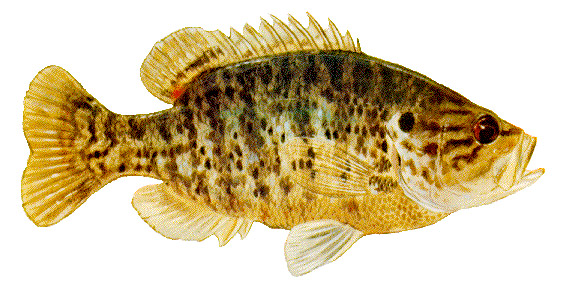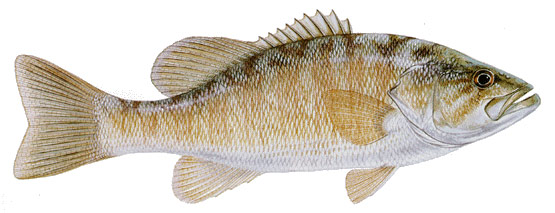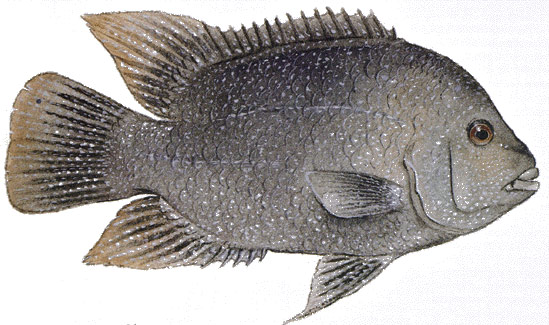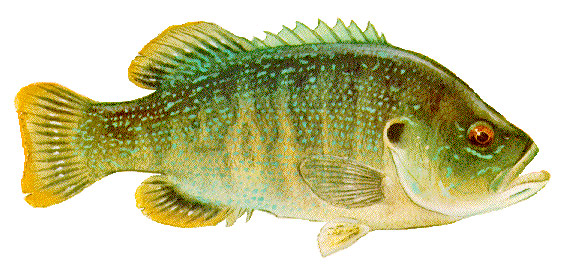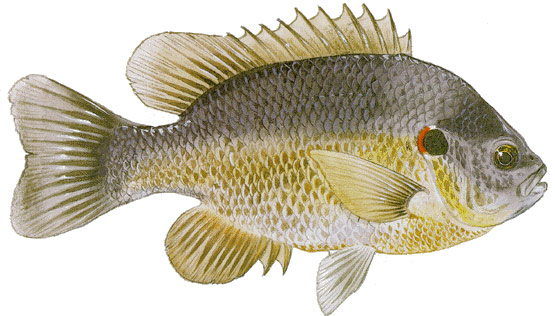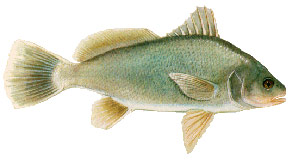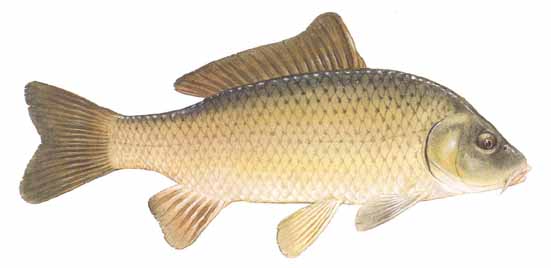Oncorhynchus is Greek meaning “hook snout”, and mykiss is the Kamchatkan name for rainbow trout. Rainbow trout have a characteristic salmon-like shape. Dark spots are clearly visible on the tail fin, which is slightly forked. The anal fin has 10-12 rays. The back is usually a dark olive color, shading to silvery white on the underside. The body is heavily speckled, and there is a pink to red stripe running lengthwise along the fish’s sides.
Category Archives: Fish Species
Warmouth Bass
The warmouth is somewhat larger than either rock bass or green sunfish (with which it is often confused) but very similar otherwise in that it is large-mouthed and heavy-bodied. Adult warmouth are dark, with mottled brown coloration. Their belly is generally golden, and males have a bright orange spot at the base of the dorsal fin. Three to five reddish-brown streaks radiate from the eyes, and the gill flaps are often red. Warmouth have three spines in the anal fin, 10 spines in the dorsal fin, and small teeth are present on the tongue. These fish range in size from 4 to10 inches (10.2 to 25 cm), but can grow to more than 12 inches (31 cm), and weigh up to 2.25 pounds (1 kg).
Striped Bass
The striped bass is the largest member of the sea bass family, often called “temperate” or “true” bass to distinguish it from species such as largemouth, smallmouth, and spotted bass which are actually members of the sunfish family Centrarchidae. Although Morone is of unknown derivation, saxatilis is Latin meaning “dwelling among rocks.” As with other true basses, the dorsal fin is clearly separated into spiny and soft-rayed portions. Striped bass are silvery, shading to olive-green on the back and white on the belly, with seven or eight uninterrupted horizontal stripes on each side of the body. Younger fish may resemble white bass (Morone chrysops). However, striped bass have two distinct tooth patches on the back of the tongue, whereas white bass have one tooth patch. Striped bass have two sharp points on each gill cover, and white bass have one. Additionally, the second spine on the anal fin is about half the length of the third spine in striped bass, and about two-thirds the length of the third spine in white bass.
Smallmouth Bass
The smallmouth bass is generally green with dark vertical bands rather than a horizontal band along the side. There are 13-15 soft rays in the dorsal fin, and the upper jaw never extends beyond the eye. Known maximum size in Texas exceeds 7.5 pounds. Micropterus is Greek meaning “small fin” [see Guadalupe bass for further explanation]. The species epithet dolomieu refers to the French mineralogist M. Dolomieu.
Rio Grande Cichlids
Cichlasoma is derived from cichla, the Greek word for “thrush.” It means “resembling cichla.” The word cyanoguttatum is also Greek and means “blue spotted.” Rio Grande cichlid are distinctive in that they exhibit cream and turquoise colored spots, giving them a speckled look. Background color varies from very dark to light olive. Lighter colored specimens usually exhibit five dark vertical bars. Both dorsal and anal fins are long and tapered extending behind the caudal peduncle (fleshy portion of the tail). Unlike tilapia and most sunfishes, which typically have three spines on the anal fin, Rio Grande cichlids are equipped with five to six anal fin spines. Adult males may also develop a pronounced “hump” on the head which is not present in tilapia. Adults usually range up to about 6 inches in length.
Green Sunfish
The green sunfish, like warmouth, has a large mouth and a heavy, black bass body shape. The body is dark green, almost blue, dorsally, fading to lighter green on the sides, and yellow to white ventrally. Faint vertical bars are apparent on the sides. Some scales have turquoise spots. Lepomis, the generic name, is Greek and means “scaled gill cover.” The species epithet cyanellus is also Greek and means “blue”.
Redear Sunfish
Lepomis, the generic name, is Greek and means “scaled gill cover.” The species epithet microlophus is Greek for “small nape.” The redear is a deep-bodied sunfish with a relatively small mouth. Color ranges from dark olive green above to almost white on the belly. The sides are usually yellow to green. The spinous dorsal fin, which is anterior to the soft dorsal fin, is normally equipped with 10 spines, although 9 or 11 spines are sometimes observed, and it is broadly connected to the soft dorsal fin. The anal fin has three spines. The species’ most distinct characteristic is the red edge on the opercle (“ear”) flap of the male (orange on the female). The opercle flap is never greatly elongated as it is in species such as the redbreast sunfish (Lepomis auritus) or the longear sunfish (L. megalotis).
Freshwater Drum
Aplodinotus is Greek for “single back”, and grunniens is Latin for “grunting”, referring to the fact that the species may be observed (or felt) making “grunting” sounds. Except for color, freshwater drum resembles its marine relative the red drum. The fish is deep-bodied and equipped with a long dorsal fin divided into two sections. The dorsal fin usually has 10 spines and 29-32 rays. Freshwater drum are silvery in color and lack the distinctive tail fin spot of red drum.
Carp
Cyprinus is Greek, and carpio is Latin; both words mean “carp.” The common carp is a heavy-bodied minnow with barbels on either side of the upper jaw. Typically, color varies from brassy green or yellow, to golden brown, or even silvery. The belly is usually yellowish-white. The dorsal fin with 17-21 rays, and the anal fin both have a heavy toothed spine. Individuals 12-25 inches in length and weighing up to 8-10 pounds are common, although they can grow much larger. Common carp may live in excess of 47 years and weigh over 75 pounds. The all-tackle world record was landed in 1987 from Lac de St. Cassien, France, and weighed in at 75 pounds 11 ounces.
Bluegill
Lepomis, the generic name, is Greek and means “scaled gill cover”. The species epithet macrochirus is also Greek and means “large hand” which may refer to the body shape or its size. Bluegills may be distinguished from other sunfish by the dark spot at the base of the dorsal fin, vertical bars on their sides, and a relatively small mouth. The spiny dorsal fin usually has 10 spines (but may have as many as 11 or as few as 9), and is broadly connected to the soft dorsal. The anal fin has three spines. The back and upper sides are usually dark olive green blending to lavender, brown, copper, or orange on the sides, and reddish-orange or yellow on the belly. Colors are more intense in breeding males, and vertical bars may take on a reddish hue.


